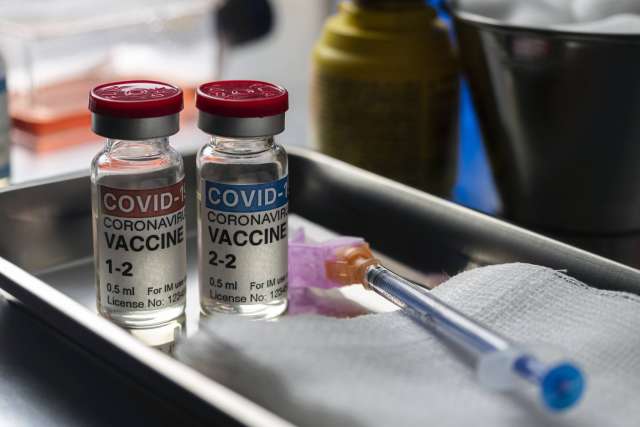As 2021 begins, hundreds of UCLA Health employees and thousands of frontline workers across the country are receiving their second dose of Pfizer’s COVID-19 vaccine.
Based on data from clinical trials, the U.S. Food and Drug Administration recommends adults receive two doses of the Pfizer vaccine about three weeks apart for maximum efficacy, estimated to be 95% seven days after the second dose. On Jan. 8, scientists with the World Health Organization said the interval between doses of the Pfizer vaccine could be extended to up to six weeks.
The second dose, however, can bring about more vaccine reactions, such as fever, fatigue, headache, muscle aches and injection-site pain, according to the FDA.
“There tends to be maybe a few more expected reactions from the second dose, particularly in individuals who are 55 years of age or younger” says Annabelle de St. Maurice, MD, MPH, co-chief infection prevention officer for UCLA Health. “It’s a sign that the immune system is reacting to something, likely to the vaccine, in producing antibodies and getting T-cells and adaptive immunity to respond.”
People with more robust immune systems, such as those who are younger, may experience more of these expected reactions, Dr. de St. Maurice says, which typically occur within the first few days after receiving the vaccine.
The timing between vaccine doses and other dosing specifics are determined in the earliest phases of clinical trials to maximize efficacy, she says. With a two-dose regimen such as Pfizer’s, the first dose stimulates and primes an immune response and the second dose serves as a “booster” to solidify that response and provide more long-term immunity.
The COVID-19 vaccines from Pfizer and Moderna, which each have received emergency use authorization from the FDA, work by telling cells to produce a protein that stimulates an immune response to COVID-19 without exposure to the disease.
Delaying the second dose
Government officials in the United Kingdom have said they intend to delay administration of the second dose of the Pfizer vaccine to provide a greater percentage of the population with an initial dose. Dr. De St. Maurice notes that this approach is not supported by scientific studies.

“Most experts agree you shouldn’t use a schedule that’s different than what’s been studied,” she says. “The two doses given in that sequence is what was determined to yield optimal efficacy.”
Scientists continue to study how long immunity generated by two doses might last. There are currently no data on how long immunity from one dose might last.
“You might give people a false sense of security,” Dr. de St. Maurice says. “It could really pose some problems. And if you’re potentially throwing away one dose of vaccine, that could also have public health implications.”
Some health officials in the U.S. have suggested using half of the recommended Moderna vaccine dose to provide vaccines for more people. Some data exist about the potential efficacy of this approach — Moderna researchers accidentally gave a half-dose to a portion of study participants — but these results were not included in the company’s submission for emergency use authorization.
“The FDA recommendation is not to give half a dose,” Dr. De St. Maurice says. “You know, the first principle of medicine is do no harm, and I think that’s something to remember when we’re making public health recommendations. We certainly don’t want to do any harm by mis-using the vaccine; it’s obviously a precious resource. I think we should use it wisely and follow the guidance from the FDA and the data that were studied.”
Some vaccines in development, including one from Johnson & Johnson currently in phase three trials involving 45,000 participants, require just one dose.
The U.K. vaccination plan also calls for a mix-and-match approach between the Pfizer and Moderna vaccines, though this also hasn’t been studied. While both formulations rely on similar messenger RNA (mRNA) technology, there is no safety or efficacy data available for mixing doses by different drug makers. FDA guidelines require both doses to come from the same manufacturer.
Vaccine hesitancy
Then there’s a segment of the population that may be hesitant to receive the vaccine. According to a Pew Research Center survey, about 60% of the general population plans to get a COVID-19 vaccine, while 21% do not. Some people, such as those who have received an organ transplant or are undergoing chemotherapy, can’t receive the vaccine because their immune systems are compromised. COVID-19 vaccines also are not available yet for children younger than 16.
Anthony Fauci, MD, the nation’s top infectious disease expert, estimates that 70% to 85% of Americans will need to be vaccinated against COVID-19 to achieve herd immunity, meaning enough people are protected from the virus to stop its spread.
Even those who have been vaccinated can remain vulnerable as long as the virus continues spreading, Dr. de St. Maurice says.
“The more people we have that are unvaccinated, the more potential there is for someone to transmit the virus to them, and for that person to transmit it to somebody else who isn’t vaccinated,” she says. “As we know, the vaccine isn’t 100% effective, so there are certainly some individuals who have received the vaccine and may think they’re protected but may actually be susceptible to the virus. So if they interact with people who are unvaccinated, they can be at risk.”
The vaccines from Pfizer and Moderna have been found safe and effective in tens of thousands of clinical-trial volunteers and millions more who’ve received them in the U.S. and U.K. under emergency use authorization. Experts say vaccines remain the planet’s best hope for ending the COVID-19 pandemic.



